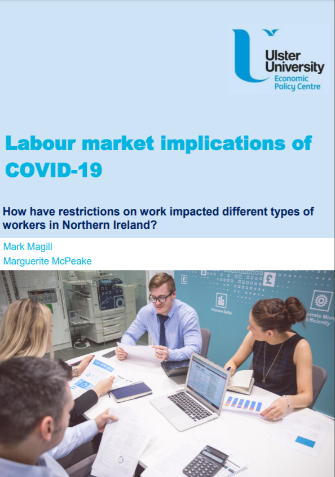LABOUR MARKET IMPLICATIONS OF COVID-19: HOW HAVE RESTRICTIONS ON WORK IMPACTED DIFFERENT TYPES OF WORKERS IN NORTHERN IRELAND
The University of Ulster ‘s Economic Policy Centre has published a detailed and thought provoking publication on how the pandemic is impacting on different types of occupations in Northern Ireland.
The authors (Magill and McPeake) highlight “It is too early to assess the scale of the economic damage on the NI economy caused by the pandemic. However, it is certain that the negative impacts will be persistent beyond the lockdown phase, and there will be a lengthy recovery period. A recent survey by the NI Chamber of Commerce highlighted the fragility of the local private sector, suggesting that two-fifths of businesses have either no or less than one month of cash reserves left . The Purchasing Managers Index for April 2020 indicated that 45% of businesses have already reduced staffing levels .”
Young people
” One of the most striking impacts from this analysis has been the disproportionate impact on the young. Unfortunately, this tells only part of the picture. The coming months will see a wave of education qualifiers seeking to enter the labour market. A significant component of qualifying students will already be in employment, working in part-time positions to support their study. However, with reduced demand for entry level positions many students from HE and FE will face difficulties transitioning from their part-time job to their chosen careers. This underemployment of graduate skills will depress intra-labour market flows and reduce vacancies available for lower qualified young people. Alongside this, qualifying students who did not work part-time to support their study will be left out of work and competing for a small number of vacancies in the short-term.
Unemployment for the 16-24 group was already at 8% prior to the crisis. In April 2020, the number of unemployed people under 25 almost doubled. At the end of the academic year approximately 25,000 students across the education system will be seeking to begin their careers after qualifying. In addition, a significant component of young workers on furlough, with their jobs vulnerable to redundancy.
Overall, the unemployment rate is expected to rise to approximately 12%. However, the effect on the 16-24 rate is much more pronounced due to the influx of education leavers into the labour market. Youth unemployment could increase significantly from a current rate of 8% to 26%, representing the highest youth unemployment rate on record (since the series began in 1995). However, it is only slightly higher than the peak youth unemployment rate in 2010 (24%), during a period where a weak recovery in the global economy and the government’s austerity policy squeezed local economic growth.
The authors argue given the severe negative impact on the young, there is merit in a special set of targeted measures. On the supply side, the most effective measure is to encourage education leavers to delay entering the labour market, and instead undertake a qualification on the next rung of the qualifications ladder. This will help avoid the long-term scarring effects associated with entering the labour market during an economic downturn, and make a significant contribution towards narrowing the gap in the unemployment rate between young people and the rest of the labour market.
The indicate it is incumbent upon education providers to ensure that there is capacity to deliver higher level courses, particularly in areas where NI is known to have skills gaps (e.g. digital skills). It is also the responsibility of the provider to sell the benefits of these courses to young people. Therefore, the provision of one-to-one careers advice via a digital platform is important, as are online careers fairs to enable students qualifying this year to explore their options. “
In Northern Ireland all school leavers are guaranteed a careers interview with a trained Careers Adviser from the CareersServiceNI (CareersNet 2020: 18) – https://www.cedefop.europa.eu/files/2020_05_27_llg_and_pandemic_cnet_b.pdf
The authors point out “Stimulating employer demand for young people in the short-term will be much more difficult. In the aftermath of the 2008/09 recession employers rushed to cut their entry level recruitment schemes, which contributed to rapidly rising youth unemployment. A policy to support employers to prevent repeating the mistakes of the past should be considered. For example, providing fiscal incentives, such as national insurance breaks, for employers recruiting young people. Funded programmes which link education institutions and employers are another avenue worthy of considerations. For example, a research fund for standalone projects in areas considered to be strategically important, with the funding contingent upon the recruitment of an education leaver. 88. This crisis has provided one clear message – no policy measure is off the table. Schemes such as the JRS on its current scale were previously unheard of. Therefore, a similar seismic policy intervention to support the young should also be included within the portfolio of interventions under consideration. Such an intervention may be a commitment to ensure that no young person is left behind as a result of this crisis. This obligation could include a guaranteed job offer (via a wage subsidy scheme), an apprenticeship or high quality training place for all young people who are unemployed for more than three months. A large scale intervention such as this will have a sizable price-tag attached to it. However, given the extent of the risk to young people being trapped in a period of worklessness and the associated scarring effect over the course of a persons’ working life, the long-term benefits may well outweigh the costs.”

